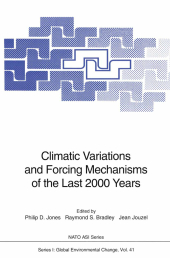 Neuerscheinungen 2011Stand: 2020-01-07 |
Schnellsuche
ISBN/Stichwort/Autor
|
Herderstraße 10
10625 Berlin
Tel.: 030 315 714 16
Fax 030 315 714 14
info@buchspektrum.de |

Raymond Stephen Bradley, Philip Douglas Jones, Jean Jouzel
(Beteiligte)
Climatic Variations and Forcing Mechanisms of the Last 2000 Years
Herausgegeben von Jones, Philip Douglas; Bradley, Raymond Stephen; Jouzel, Jean
Softcover reprint of the original 1st ed. 1996. 2011. x, 653 S. X, 649 pp. 235 mm
Verlag/Jahr: SPRINGER, BERLIN 2011
ISBN: 3-642-64700-6 (3642647006)
Neue ISBN: 978-3-642-64700-0 (9783642647000)
Preis und Lieferzeit: Bitte klicken
Proceedings of the NATO Advanced Research Workshop "Climatic Variations and Forcing Mechanisms of the Last 2000 Years", held at Il Ciocco, Lucca, Italy, October 3-7, 1994
A profound knowledge of the past climate is vital for our understanding of global warming. The past 2000 years are both the period which is of most relevance to the next century and that for which there is the most evidence. High-resolution proxy records for this period are available from a variety of sources. Five sections consider dendroclimatology, ice cores, corals, historical records, lake varves, and other indicators. The final two sections cover the histories of various forcing factors and attempt to bring together records from a variety of sources and provide explanations.
Section A: Dendroclimatology.- Tree-Ring Variables as Proxy-Climate Indicators: Problems with Low-Frequency Signals.- Tree-Ring Density Networks for Climate Reconstruction.- Millennial and Near-Millennial Scale Dendroclimatic Studies in Northern North America.- Reconciling the Glacial and Dendrochronological Records for the Last Millennium in the Canadian Rockies.- Multimillennial Dendroclimatic Studies from the Western United States.- Large-Scale Climatic Influences on Baldcypress Tree Growth Across the Southeastern United States.- Inter-Decadal Climate Oscillations in the Tasmanian Sector of the Southern Hemisphere: Evidence from Tree Rings over the Past Three Millennia.- Interdecadal Climatic Variations in Millennial Temperature Reconstructions from Southern South America.- Section B: Ice Cores.- Frequency Analysis of an Annually Resolved, 700 Year Paleoclimate Record from the GISP2 Ice Core.- Climate Reconstruction from Water Isotopes: What do we Learn from Isotopic Models?.- Climate Changes in the Atlantic Sector of Antarctica Over the Past 500 Years from Ice-Core and Other Evidence.- Holocene Climate Changes Recorded in an East Antarctica Ice Core.- Climatic Changes for the Last 2000 Years Inferred from Ice Core evidence in Tropical Ice Cores.- Inter-Comparison of Ice Core ?18O and Precipitation Records from Sites in Canada and Greenland over the Last 3500 Years and over the Last Few Centuries in Detail Using EOF Techniques.- Section C: Corals.- Coral Records of Climate Change: Understanding Past Variability in the Tropical Ocean-Atmosphere.- The Potential of Massive Corals for the Study of High-Resolution Climate Variation in the Past Millennium.- Eastern Pacific Corals Monitor El Ni¤o/Southern Oscillation, Precipitation, and Sea Surface Temperature Variability Over the Past 3 Centuries.- Section D: Historical Evidence.- Reconstructions of Past Climate from Historical Sources in the Czech Lands.- The Analysis of Two Bi-Millennial Series: Tiber and Po River Floods.- Section E: Varved Sediments.- High Resolution Lacustrine Sediments and their Potential for Paleoclimatic Reconstruction.- Varved Sediment Records of Recent Seasonal to Millennial-Scale Environmental Variability.- Section F: Forcing Factors.- Intercomparisons of Proxies for Past Solar Variability.- Reconstructions of Past Solar Variability.- The Volcanic Record in Ice Cores for the Past 2000 Years.- Changes in Trace Gas Concentrations During the Last 2000 Years and More Generally, the Holocene.- The Potential for Modeling the Effects of Different Forcing Factors on Climate During the Past 2000 Years.- Section G: Conclusions.- Temperature Changes on Long Time and Large Spatial Scales: Inferences from Instrumental and Proxy Records.- Are There Optimum Sites for Global Paleotemperature Reconstruction?.- What Can the Instrumental Record Tell us About Longer Timescale Paleoclimatic Reconstructions?.- Conclusions and Recommendations.


